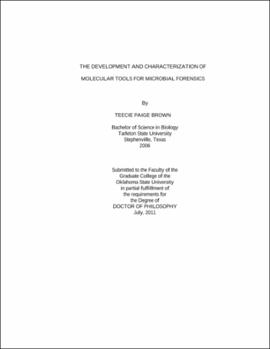| dc.contributor.advisor | Melcher, Ulrich K. | |
| dc.contributor.author | Brown, TeeCie Paige | |
| dc.date.accessioned | 2013-11-26T08:22:49Z | |
| dc.date.available | 2013-11-26T08:22:49Z | |
| dc.date.issued | 2011-07 | |
| dc.identifier.uri | https://hdl.handle.net/11244/6635 | |
| dc.description.abstract | Scope and Method of Study: | |
| dc.description.abstract | The anthrax attacks of 2001 prompted the rapid establishment and growth of the fields of microbial and plant pathogen forensics. A complete forensic capability includes the ability to discriminate between a natural and an intentional disease outbreak, collection of forensic evidence, generation of genetic profiles for use during attribution and storage of samples. This document describes (i) the molecular characterization of plant virus populations derived from plants that were naturally and mechanically-inoculated with a model plant virus, (ii) the application of microarray-based technologies to genetically fingerprint plant viruses, (iii) the characterization of a previously-designed microarray platform for the identification and diagnosis of known and novel plant viruses, and (iv) the use of FAME profiles to aid in the discrimination of media components used to prepare Bacillus cereus T-strain spores. Though all of these projects are not directly related, they all fall within the scope of microbial forensics. | |
| dc.description.abstract | Findings and Conclusions: | |
| dc.description.abstract | The molecular characterization of plant virus populations derived from a natural inoculation event and those from mechanically-inoculated plants displayed minor differences in haplotype and pair-wise nucleotide diversities. Additionally, the number of recombination events was found to be lower in the mechanically-inoculated plants than those collected from the natural disease outbreak. These results indicate that differences between the two types of inoculation events exist and may be a direct function of the infection time, source(s) of inoculum(a) or environmental effects. | |
| dc.description.abstract | The solution-based minisequencing and capture array technique demonstrated reproducibility at the same concentration of targets, but was less accurate using variable amounts of synthetic targets. The use of solution-based minisequencing followed by tag-array capture appears to be a promising approach to genotyping plant viruses. | |
| dc.description.abstract | A significant amount of cross-hybridization was observed using the universal plant virus microarray (Virochip). The microarray platform failed to strongly hybridize to most of the known plant viruses that were applied to the array. Hybridization with Wheat streak mosaic virus-infected material indicated that the system strongly hybridized with the negative-sense strand, but not the corresponding positive-sense strands. | |
| dc.description.abstract | Discrimination of individual media components was achieved by analyzing fatty acids derived from Bacillus cereus T-strain spores prepared in different media. One FAME biomarker, oleic acid, was found to be exclusively associated with media supplemented with blood. | |
| dc.format | application/pdf | |
| dc.language | en_US | |
| dc.rights | Copyright is held by the author who has granted the Oklahoma State University Library the non-exclusive right to share this material in its institutional repository. Contact Digital Library Services at lib-dls@okstate.edu or 405-744-9161 for the permission policy on the use, reproduction or distribution of this material. | |
| dc.title | Development and characterization of molecular tools for microbial forensics | |
| dc.contributor.committeeMember | Fletcher, Jacqueline | |
| dc.contributor.committeeMember | Allen, Robert | |
| dc.contributor.committeeMember | Hoyt, Peter | |
| dc.contributor.committeeMember | Canaan, Patricia | |
| osu.filename | Brown_okstate_0664D_11534.pdf | |
| osu.accesstype | Open Access | |
| dc.type.genre | Dissertation | |
| dc.type.material | Text | |
| thesis.degree.discipline | Biochemistry and Molecular Biology | |
| thesis.degree.grantor | Oklahoma State University | |
